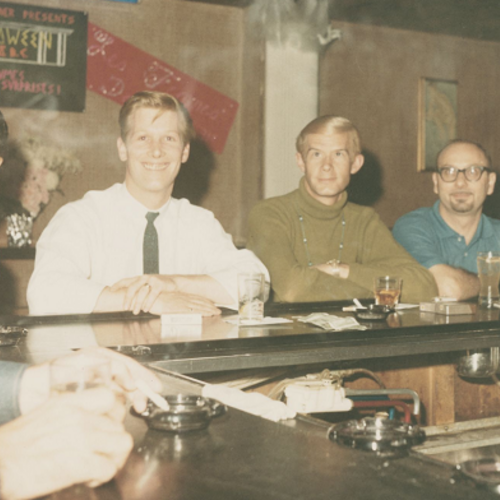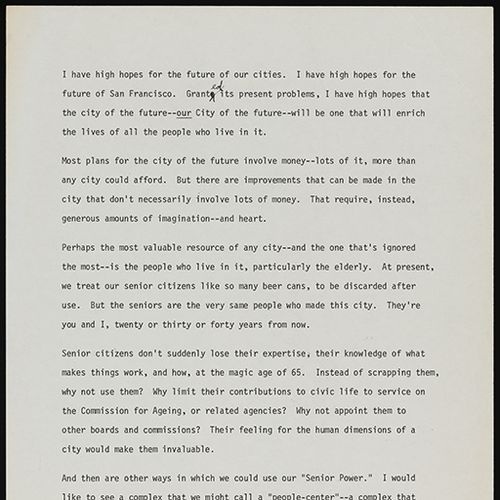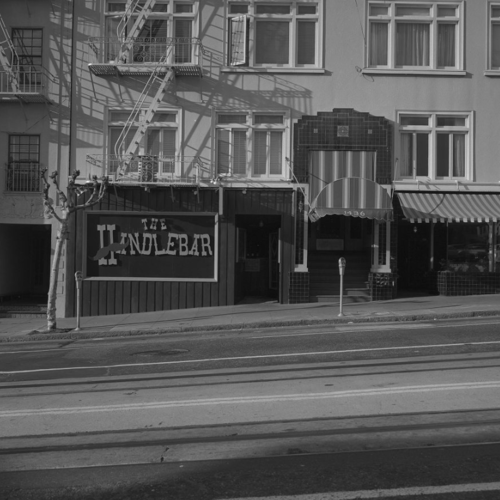Show moreThe scrapbook contains newspaper clippings from 1954-1955 that document the police raid on Tommy's Place and the arrest and trial of Grace Miller and Joyce van de Veer. Their lawyer was Robert Cort. On September 9, 1954 Grace Miller and Joyce van de Veer were arrested for contributing to the delinquency of minors. Bars they owned, 12 Adler Place and Tommy's Place (529 Broadway), were reportedly rendezvous points for teenage girls to gain access to alcohol, marijuana, and to meet older men and women. Later clippings concern the sentencing of Grace Miller to two terms in jail (two 6-month sentences to run concurrently). The scrapbook also includes a letter to "Gracie" from many friends bemoaning her unfair treatment.
Show less
Show moreThe collection documents the gay bar culture of Bradley's Corner Bar with 370 color prints of mostly men and some lesbian women. Bradley's Corner Bar, 1949 - 1987, was a neighborhood tavern located at 900 Cole Street in San Francisco. In March 1965, the tavern became a gay bar. In 1967, the bar was owned by Harold (Bill) Lloyd Giddings and Thomas (Tom) W. Stuart. Giddings became the sole proprietor in 1971 and owned the bar until 1987. Bill Giddings compiled this collection of photographs of Bradley's Corner Bar. The bar events documented in the photographs include Halloween with cross-dressing, holiday and birthday parties and one wedding celebration. Most of the photographs are of the interior of the bar with a few exterior shots. The photographs not of the bar include a bus trip to Guerneville and house parties.
Show less
Show moreDraft speeches and writings relating to issues Milk considered important. The "Hope" and the "Neighborhoods" speeches are among those in draft form. Drafts and copies of Milk's column for the Bay Area Reporter and the Sentinel are also included in the writings.
Show less
Show moreHarvey Milk recorded three audiotapes on November 18, 1977, 10 days after his election to the San Francisco Board of Supervisors. The tapes contain his thoughts on who would best continue his political work should he be killed. For this reason, the recordings are known as Milk’s “political will,” or alternatively, as the “in case tapes” according to Milk’s friend and fellow activist Daniel Nicoletta. Each tape was sent to a different person: Tape 1 to Milk’s personal attorney John Wahl; Tape 2 to Milk’s friend and political associate Walter Caplan; and, Tape 3 to Milk’s close friend Frank Robinson. In his book, “The Mayor of Castro Street,” Randy Shilts notes that Milk used an outline to organize his thoughts; consequently, each recording has slight variations. This recording is a copy of Tape 1, which was given to John Wahl, and was played for Dianne Feinstein on the day of Harvey Milk’s and George Moscone’s assassinations, November 27, 1978. Nicoletta notes that it was Wahl and his then-partner Larry Hughes who first played the tape for Feinstein. A transcript of Tape 2 (sent to Walter Caplan) is published in “The Mayor of Castro Street” and in “An Archive of Hope.” It includes the name of a fifth person, Doug DeYoung, who Milk thought was unsuitable to continue his political work. Tape 3 (sent to Frank Robinson) is the only one that includes the phrase “if a bullet should enter my brain, let that bullet destroy every closet door.” The survival and whereabouts of Tape 3 are unknown.
Show less
Show moreLee Raymond was born and raised in Southern California and then lived in San Francisco. Raymond was an Empress of the Imperial Court, a fashion designer, and a drag performer in San Francisco, circa 1974-1979. Raymond owned a fashion boutique called R.V.H. Ltd. with Richard Hayward. As a drag performer, Raymond used the stage name Flame.
Show less
Show moreIn the 1930s, after an investigation into San Francisco Police Department corruption found a network of payoffs from numerous underground industries and organizations, the SFPD was restructured in an attempt to curb the flow of illegal money. The concept of “police professionalism” was utilized, a municipal philosophy which concentrates power at the top of the chain of command and relies on honest leadership to function. As much of the payola had come from gambling and prostitution rings, responsibility for these “vice crimes” was transferred from district chiefs to a new unit, the Bureau of Special Services (BSS), whose investigators reported directly to the Chief of Police. BSS officers focused their investigations on gambling and bookmaking, but also investigated rape, sodomy, and displays of prophylactics. This collection contains photographic negatives of BSS cases from 1945-1969, including the housing envelopes with pertinent case information. Sites of investigation included bookstores, sex-oriented businesses, theaters, and art shows that featured gay and lgbtq+ content.
Show less




![Harvey Milk's "Political Will" [audio recording given to John Wahl]](https://digitalsf.org/sites/default/files/styles/enhanced_grid_small/public/externals/f10b0aa728593f4bf81bd67fd2a85615.png?itok=nYlYCqVo&pid=islandora:194670&iic=true)


